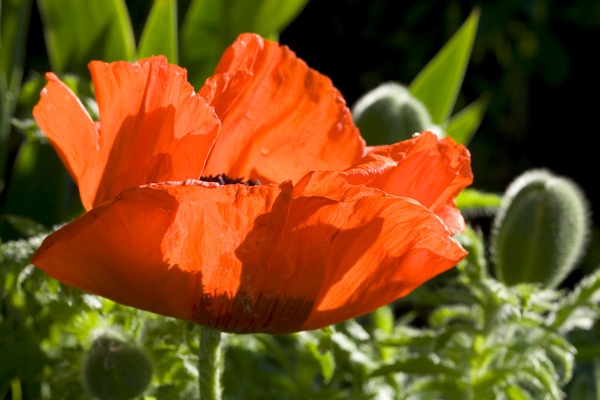Embracing Backlighting
A few weeks ago I shared some thoughts about the benefits of (carefully) shooting into the sun. The example given there demonstrated the intensity of color that could be obtained by backlighting leaves in a tree. This week I want to share how this technique can be applied to close-ups of flowers.
With close-ups, you have a little more freedom to orient the camera. In fact, you don’t have to shoot quite as directly into the sun to get this effect. Unlike the tree shot, where I had to hide the sun behind a branch or a trunk of a tree, here the sun is not even in the frame. You still have to be careful that the sun doesn’t shine onto the front element (or filter) of your lens; a lens shade is particularly useful in this regard, helping to avoid a nasty flare which could ruin your image.
Many flowers can be rendered dramatically in this light, and I have enjoyed good results with tulips, irises, daffodils, crocuses, and columbine. However, this large poppy was particularly successful. The crepe paper-like petals of the poppy not only transmitted beautifully intense light and saturated color, but also provided for rather sharply focused shadows cast upon the petals, leading to an enhanced 3-D effect.
When using natural light for this kind of shot, I have found that low-angle light, shortly after sunrise, is the easiest to work with because the shadows are more dramatic and the camera angle can be close to level, allowing me to capture both the bottom and the top of the flower. If the angle of light is not enough reward for waking up early, the color of the light is also warmer at this hour, which compliments the colors in the foliage. On a cloudy day or when working in the shade, you can also use electronic flash and/or reflectors to provide a little more control over the angle of the light. In fact, with electronic flash you can illuminate the flower from underneath, allowing your camera angle to be a little higher and affording a view into the flower instead of just the side of the flower.
This image was captured at 06:32 local time with a 100mm f2.8 macro lens mounted on a Canon EOS-5D camera. The exposure was 1/40s at f/11. A tripod was used to control composition and to keep the camera stationary to maintain critical focus and enable the slower shutter speed. No flash or artificial reflectors were used.

Tip of the Week
2007.03.12

